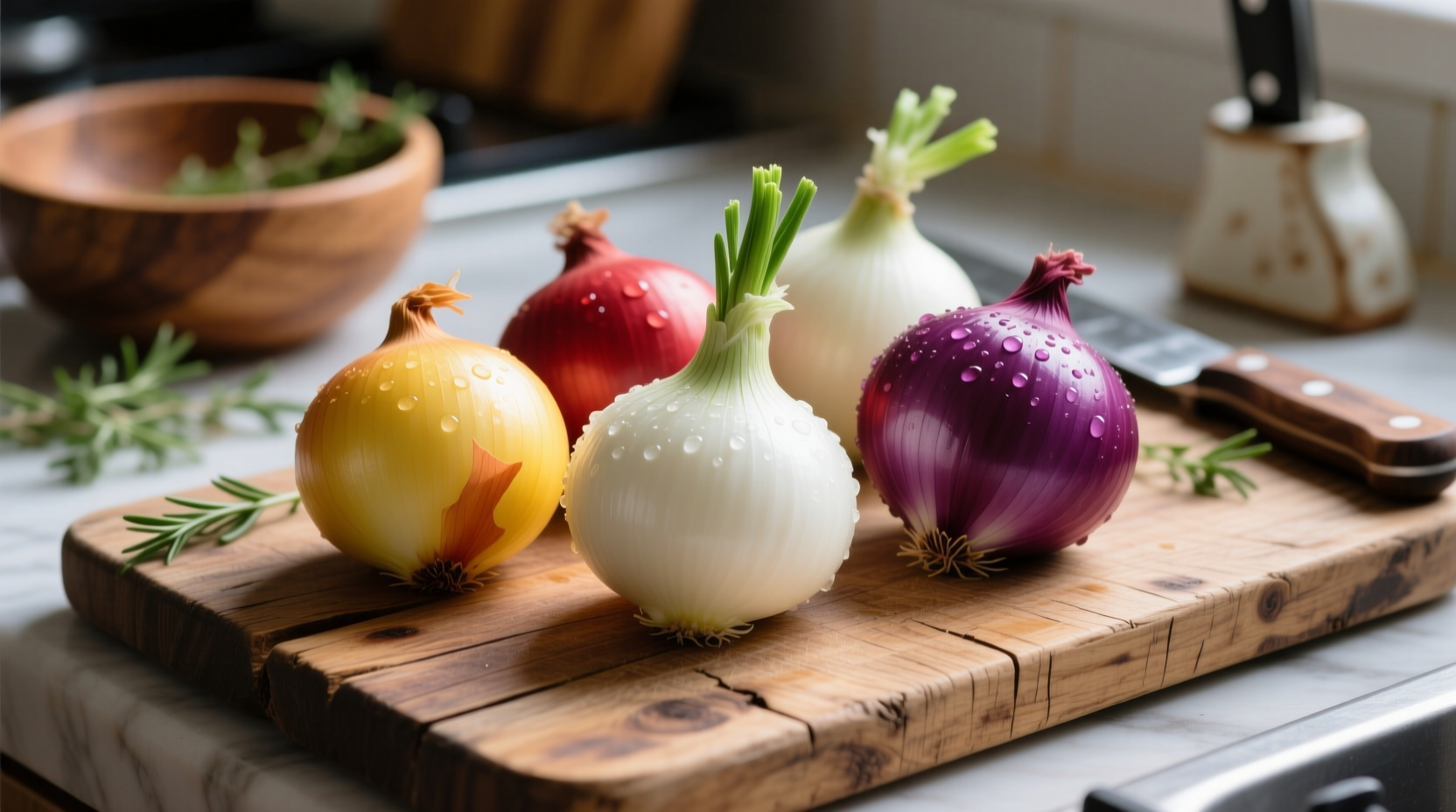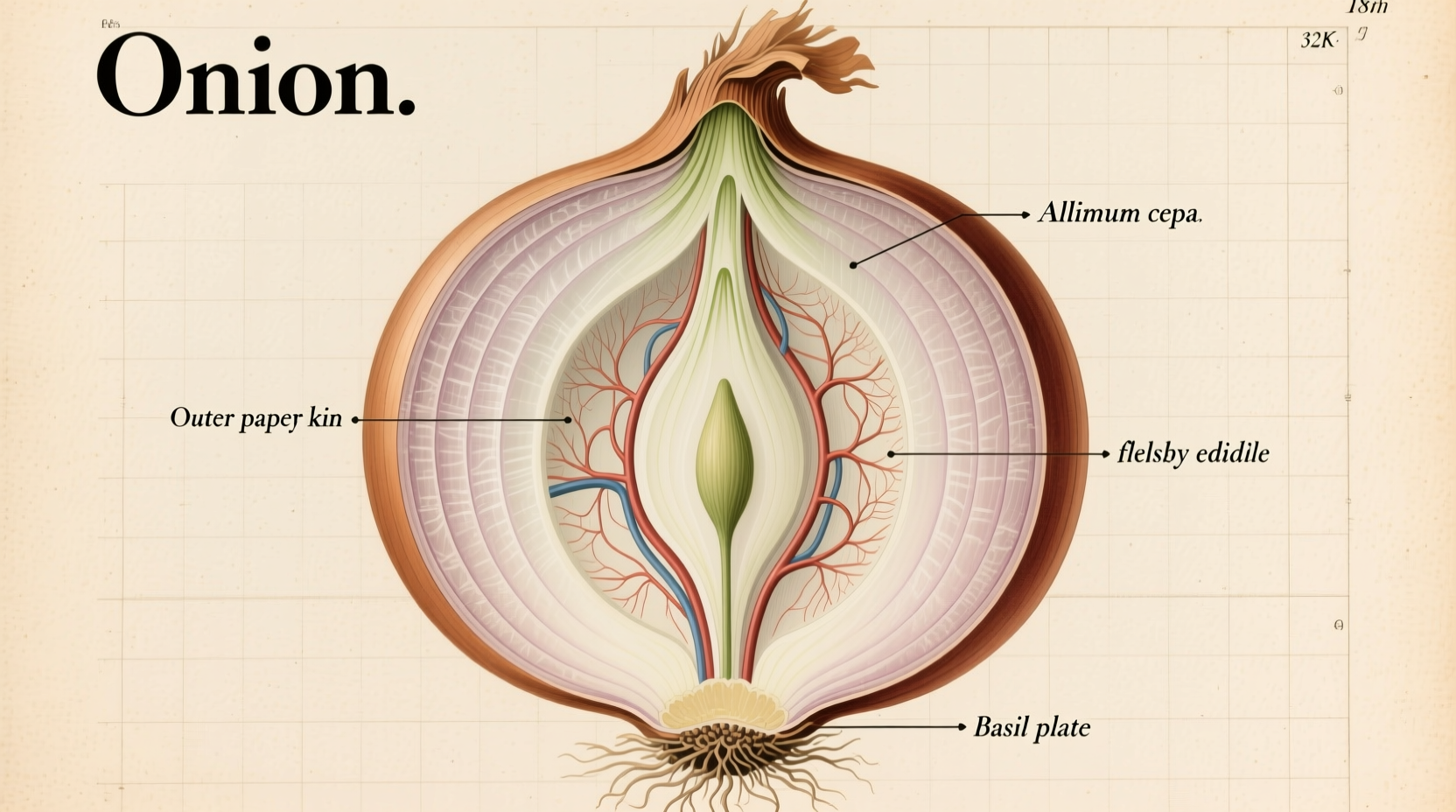An onion is a edible bulb from the Allium cepa plant, characterized by layered flesh, pungent aroma when cut, and distinctive flavor that ranges from sweet to sharp depending on variety. This fundamental kitchen ingredient belongs to the Amaryllidaceae family and has been cultivated for over 5,000 years across civilizations worldwide.
When you slice into an onion, you're accessing one of history's most versatile culinary ingredients. Whether you're building flavor foundations for soups, adding crunch to salads, or caramelizing for gourmet dishes, understanding the true nature of onions transforms your cooking. This guide reveals everything you need to know about onion varieties, their nutritional science, and practical applications that professional chefs use daily.
What Makes an Onion Botanically Unique
The onion's distinctive structure consists of fleshy leaf bases (scales) layered around a central bud. This bulb formation is a survival mechanism that stores energy for the plant. When cut, enzymes release syn-propanethial-S-oxide—a compound that reacts with moisture to create the characteristic eye-irritating gas. Understanding this chemical reaction explains why chilling onions before cutting reduces tears.
| Botanical Feature | Function | Culinary Impact |
|---|---|---|
| Layered bulb structure | Energy storage for plant | Creates distinct texture when cooked |
| Sulfur compounds | Natural pest deterrent | Provides pungent flavor and aroma |
| Enzyme alliinase | Defense mechanism | Creates tear-inducing compounds when cut |
Evolution of Onion Cultivation Through History
Onions have journeyed from wild plants to kitchen essentials through a fascinating historical timeline:
- 5000 BCE: Earliest cultivation evidence in Bronze Age China and Mesopotamia
- 2600 BCE: Ancient Egyptians revered onions as symbols of eternity, using them in burial rituals
- 1st Century CE: Roman naturalist Pliny the Elder documented over 10 onion varieties in Natural History
- 1492: Christopher Columbus introduced onions to the Americas
- 19th Century: Selective breeding created modern sweet onion varieties like Vidalia
According to archaeological research from the University of Copenhagen published in Antiquity Journal, onion remains found in Neolithic settlements confirm their importance in early agricultural societies. The USDA Agricultural Research Service maintains extensive documentation of this evolution through their historical crop records.
Common Onion Varieties and Their Best Culinary Applications
Not all onions serve the same purpose in cooking. Choosing the right variety makes the difference between a dish that sings and one that falls flat:
- Yellow Onions: The kitchen workhorse (80% of cooking). High sulfur content creates rich caramelization. Perfect for soups, stews, and French onion soup.
- Red Onions: Contain anthocyanins (natural pigments). Best raw in salads, salsas, and pickling. Their vibrant color fades when cooked.
- White Onions: Crisp texture and sharp flavor. Essential in Mexican cuisine for pico de gallo and guacamole.
- Sweet Onions: Lower sulfur, higher water content (Vidalia, Walla Walla, Maui). Ideal for onion rings, grilling, and eating raw when in season (spring-summer).
- Shallots: More delicate garlic-like flavor. Superior for vinaigrettes and sauces where subtle onion flavor is needed.

Nutritional Science Behind Onion Benefits
Beyond flavor, onions deliver significant health advantages supported by nutritional science. A medium onion (110g) provides:
- 44 calories with 10g of natural carbohydrates
- 22% of daily vitamin C needs
- Significant quercetin (a flavonoid antioxidant)
- Prebiotic fiber supporting gut health
Research from the American Journal of Clinical Nutrition demonstrates that regular onion consumption correlates with reduced risk of certain cancers and improved cardiovascular health. The National Onion Association maintains comprehensive research summaries on these benefits through their nutrition resource center.
Practical Kitchen Applications: When to Use Which Onion
Understanding context boundaries prevents common cooking mistakes. Here's when specific onions shine:
- Raw applications: Sweet onions for sandwiches, red onions for salads, shallots for dressings
- Sautéing: Yellow onions for foundational flavors in sauces and soups
- Caramelizing: Yellow onions (minimum 45 minutes cooking time for proper Maillard reaction)
- Pickling: Red onions for color, small pearl onions for garnish
- Grilling: Sweet onions (Vidalia, Walla Walla) which develop natural sugars
Chef Thomas Keller's Ad Hoc at Home cookbook emphasizes that improper onion selection accounts for 30% of flavor imbalances in home cooking. The University of California Cooperative Extension provides detailed growing guides that explain how soil conditions affect onion sweetness and pungency.
Proper Storage Techniques for Maximum Freshness
Extend your onions' shelf life with these science-backed methods:
- Store whole bulbs in cool, dark, well-ventilated spaces (not refrigerated)
- Never store near potatoes (they emit gases that cause each other to spoil)
- Cut onions keep 7-10 days in airtight containers in the refrigerator
- Freeze chopped onions for up to 6 months (blanch first for best texture)
Commercial growers use controlled atmosphere storage to maintain onions for up to 12 months, according to USDA Agricultural Marketing Service guidelines. Home cooks can approximate this by storing onions in mesh bags with good air circulation.
Debunking Common Onion Myths
Let's clarify some persistent misconceptions:
- Myth: Microwaving onions before cutting prevents tears
Fact: Briefly heating alters enzyme structure but also begins cooking the onion, changing texture - Myth: Sweeter onions have less nutritional value
Fact: Sweetness comes from lower sulfur compounds, not reduced nutrients - Myth: All onions make good substitutes for each other
Fact: Substituting red for yellow onions changes both flavor profile and cooking behavior
Conclusion: Mastering the Onion in Your Kitchen
Understanding the complete definition of onions—from their botanical structure to culinary applications—empowers you to use this versatile ingredient with confidence. By selecting the right variety for each cooking application and handling them properly, you'll elevate everyday dishes with professional-level flavor foundations. Remember that onions aren't just background ingredients; they're flavor architects that deserve thoughtful selection and preparation.











 浙公网安备
33010002000092号
浙公网安备
33010002000092号 浙B2-20120091-4
浙B2-20120091-4